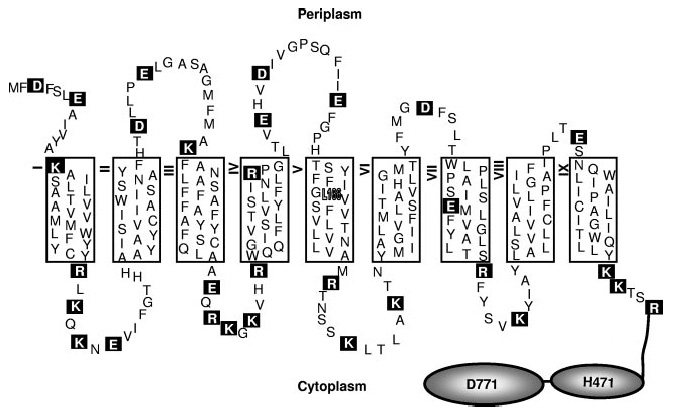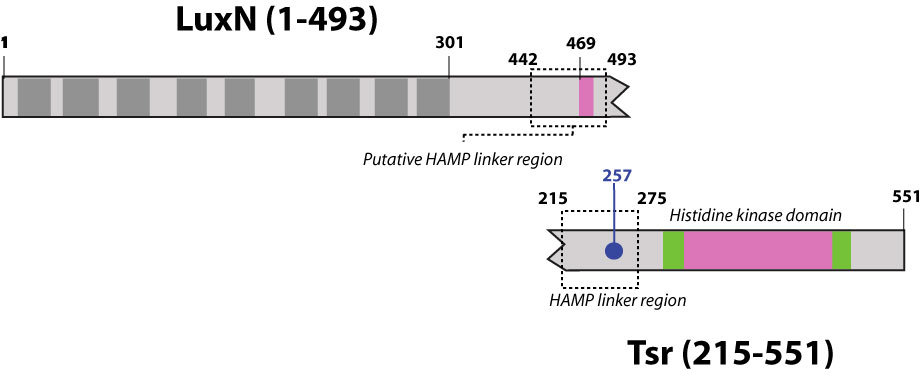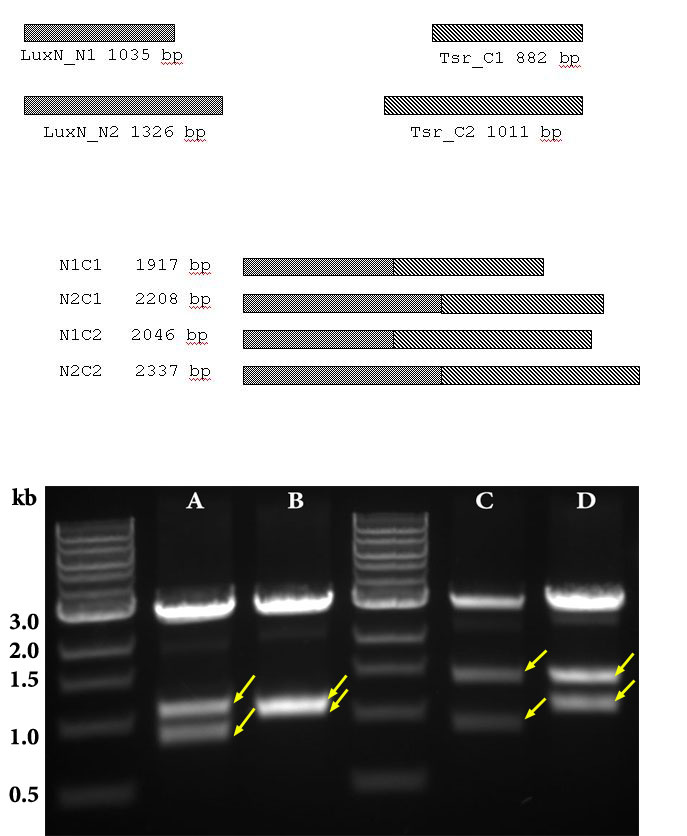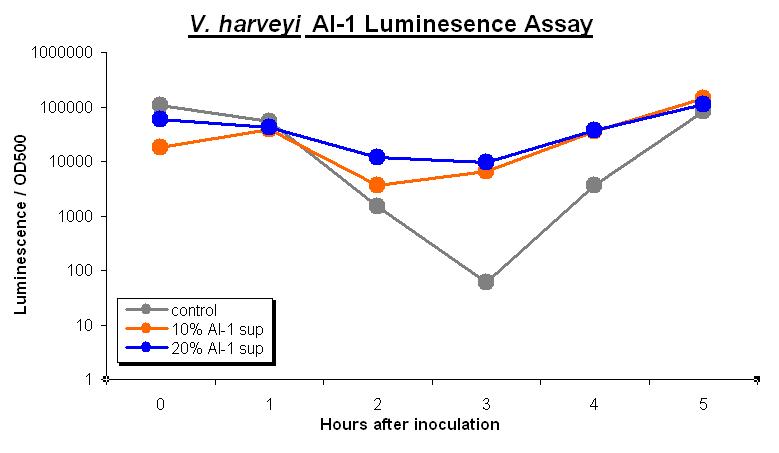Rice/Project B: Quorumtaxis
From 2007.igem.org
| Line 1: | Line 1: | ||
| - | [[Image: | + | [[Image:Bolt.jpg|right|650px]] |
<BR> | <BR> | ||
= '''Quorumtaxis Project''' = | = '''Quorumtaxis Project''' = | ||
Revision as of 03:47, 27 October 2007
Contents |
Quorumtaxis Project
Background
In 1973, [http://www.pnas.org/cgi/reprint/70/11/3240 Cohen and Boyer] ushered in the age of molecular biology by developing techniques allowing for the expression of foreign genes in bacteria. In the decades since, scientists have used recombinant DNA technology to express heterologous genes in a variety of organisms. We are now on the threshold of a more radical re-engineering of biological systems – the engineering of artificial genetic systems which give rise to complex phenotypes in organisms. In essence, we are redesigning biological behavior to suit our purposes. Here we describe the design and characterization of a completely novel bacterial phenotype: quorumtaxis.
A relatively recent discovery in cell biology which has garnered great interest is quorum-sensing, the method whereby populations of bacteria are able to detect their own density through the secretion of small molecule pheromones, known as 'autoinducers'. In doing so, bacteria are able to synchronize the switching on and off of phenotypes which are dependent upon total cell density. For example, the model system for this is the Vibrio family of marine bacteria that uses quorum-sensing to control synchrony for luminescence expression, which is most optimal when cell densities are high.
In contrast, chemotaxis is a well-studied bacterial system, as it plays a central role in bacterial fitness and is a nice system for the study of protein signaling. The bacterial chemotaxis system has been exquisitely optimized through evolution to provide for the detection and cellular motility towards nutrients or away from toxins. In essence, it is the chemotaxis pathways which make these cells 'predators' rather than passive feeders.
The objective of the quorumtaxis project is to engineer Escherichia coli which are able to actively pursue and mark or eliminate another bacterial target by homing in on its quorum pheromones. This system can be divided into three components: an input element, a processing element, and a response element. The input element will consist of a quorum sensing circuit which would allow specific detection of the bacterial target. The processing element will facilitate the signaling of this input into controlled responses. A number of different response elements can be conceived, to be used separately or in tandem: 1) integration into the chemotactic pathway of E. coli, allowing for directed mobilization towards the target, 2) reporter response at high pheromone concentrations to allow for visual identification of the target location (e.g., GFP production), and 3) an elimination response to produce molecules which are specifically lethal to the desired target. The keystone of this project will be the design of a chimeric protein receptor which is able to detect the quorum pheromone via a periplasmic sensory domain and transmit this to a cytoplasmic domain which will alter cellular chemotaxis accordingly.
Glossary
Quorum sensing = natural basic cellular system in which bacteria are able to detect their own density (and the density of other bacteria) using signaling small-molecules.
Autoinducer (AI) = the name given to the signaling small-molecules described above, essentially quorum pheromones.
Chemotaxis = natural basic cellular system in which detection of a substrate in the environment results in the alteration of flagellar rotation. The result is a biased random-walk, resulting in movement towards from nutrients or away from toxins.
Methyl-Accepting Chemotaxis Proteins (MCPs) = these are the periplasmic chemotaxis receptors. In response to substrates in the environment, these receptors intitate a phosphorylation signal cascade affecting flagellar proteins. The two major MCPs in E. coli are Tsr (serine-sensing) and Tar (aspartate-sensing).
Quorumtaxis = artificial phenotype in which bacteria are able to detect and chemotaxis towards another bacterial species or strain, based on concentrations of quorum-sensing pheromones.
Motivation
Bacterial targeting is a critical aspect in the development of bacteria-based therapies, spatial patterning, and biosensor platforms. For passive targeting, groups have attempted to improve bacterial targeting by increasing attachment to targets with high specificity. However, this strategy is dependent on global and local diffusion of the bacteria. In contrast, bacteria themselves have evolved a mechanism for active targeting, chemotaxis. The significance and superiority of this natural spatial search algorithm is evident in the fact that prokaryotic and eukaryotic cellular chemotaxis is one of the most basic cellular responses to the environment. Over the past decade, a number of groups have demonstrated that the chemotactic behavior of E.coli (the model system) can be re-engineered to sense other ligands by protein engineering of chimeric receptors or the expression of synthetic riboswitches. These milestones improve the toolbox of methods available to control the spatial movement of bacteria. However, to date there has been no demonstration of an engineered chemotaxis system able to detect and move towards other bacterial species. Such a system will pave the way for new applications:
- The engineering of bacteria which are able to hunt other target bacteria (e.g., bacteria known to cause infectious diseases). This capability would require the coupling of quorumtaxis with a target kill mechanism.
- Bacteria which would serve as trackable biosensors – by actively pursuing other bacterial targets, a trail could be established to facilitate localization of the target (a la Hansel and Gretel).
- Enhancing the efficiency of bacteria-based therapies. The [http://www.voigtlab.ucsf.edu/ Voight lab at Caltech] has developed ‘’E.coli’’ which are able to invade and kill cancer cells. Integrating specific chemotaxis towards the cancer cells in these bacteria would greatly enhance their therapeutic potential.
- A proof of principle in redesigning cellular chemotaxis systems – one day, more complex chemotaxis systems may be re-engineered. For example, the reprogramming of human neutrophils to seek and destroy specific targets within the body. From the paradigm of designing such programmable cells as meso-scale agents capable of complex tasks such as biomaterials assembly, tissue engineering, and cell-based therapy, the control of chemotactic behavior will be paramount.
Following up on this body of work, our iGEM team asked the following question:
Can we re-engineer E.coli to recognize and pursue other bacterial species? Do quorum-sensing receptors and chemotaxis receptors have enough functional modularity to facilitate coupling of these functions by swapping and fusing the functional domains together?
Goals
To successfully develop quorumtaxis, we will engineer E.coli to sense concentration gradients of N-3-hydroxybutanoyl-L-homoserine lactone (commonly called AI-1 for autoinducer 1), the primary quorum pheromone for the marine bacterium Vibrio harveyi. The system must retain sufficient sensory adaptation to continually maintain sensitivity to differences in local concentrations of AI-1. This sensory adaptation is core to the efficiency of bacterial chemotaxis systems. In summary, a successful quorumtaxis system will:
- Sense a trans-species AI-1 pheromone in the environment.
- Detection of AI-1 will be transmitted through the E.coli chemotaxis pathway and switch the flagellar rotation towards smooth swimming.
- Ideally, the quorumtactic behavior will have the appropriate dynamic range for adapting to different local AI-1 concentrations.
- After successful demonstration, a stretch goal will be to couple quorumtaxis to a genetic circuit which produces an output in response to higher AI-1 concentrations. For example, after quorumtaxis results in migration towards the target cells, the higher local AI-1 could induce a kill(er) circuit that would release toxic peptides or phage capable of killing the target cells. In essence we could design through synthetic biology methods programmable ‘seek and destroy’ bacteria (Figure 1).
Experimental System and Circuit Design
History
For last year’s iGEM competition, we had designed the quorumtaxis system using the sensing domain of ComP, the quorum-pheromone receptor for B. subtilis. However, in a reassessment of this strategy, we decided that a number of potentially insurmountable obstacles need to be examined. First, there is no precedent for the expression of functional ComP in E. coli. Difficulties such as membrane insertion may preclude the engineering of a functioning ComP-Tsr hybrid. In addition, the ability of significant amounts of the ComX pheromone to enter the periplasmic space of E. coli has not been shown. These difficulties highlight some of the inherent difficulties in engineering chimeric proteins from physiologically divergent (gram -/+) bacteria.
Design of a LuxN-Tsr Chimeric Receptor
This year, we have selected the quorum receptor LuxN from V. harveyi as our source for the sensor domain. We will still use the signaling domain from Tsr, the major E.coli MCP. The rationale for this is that both of these bacteria are gram negative, decreasing the probability of a nonfunctional chimeric receptor arising from differences in codon bias, membrane composition, or access to the AI-1 pheromone. Compatibility considerations for the LuxN sensor domain and the Tsr signaling domain:
- Both E.coli and V.harveyi are gram negative.
- AI-1 of V.harveyi has been successfully produced in E.coli through the heterologous expression of the synthesis operon LuxLM.
- The autoinducer AI-1 which binds to LuxN is not commonly shared between other gram negative bacteria.
- LuxN has been expressed in E. coli and shown to localize to the membrane and be catalytically active.
- LuxN has been previously cloned by the Bassler laboratory (Princeton).
- Procedures for the production of AI-1 and assays to test for AI-1 presence have been developed by the Bassler laboratory.
The key to the engineering of a functional chimera will be in the proper positioning of the fusion site between the two domains. Transmission of information between the sensor domain and signaling domain occurs through a change in protein conformation. Ottenman and colleagues (1999) have theorized that upon binding to the substrate, the MCP structural changes results in a piston-like movement of the transmembrane helices, relative to the plane of the periplasmic membrane. Thus, in replacing the periplasmic sensor domain, the spacing relative to the cytoplasmic signaling domain will be critical to ensure proper switching between the phosphorylation states. Our strategy is to first design and construct four LuxN-Tsr chimeras with different spacings between the domains. Preliminary swarming assay screens will be then be used to assess for any desired quorumtacic function. These four chimeras will then be used as templates in a method called ITCHY (incremental truncation for the creation of hybrid enzymes) to generate libraries of chimeras with a range of difference spacing between the domains. Interesting phenotypes acquired from this library can be further optimized through directed evolution.
Selection of Splice Sites for LuxN and Tsr
A number of chimeric MCP receptors have been previously engineered (however, no quorum receptors have ever been used). Unfortunately, this information is not helpful for suggesting a splice site for the LuxN receptor. The N-terminal sensor portion of LuxN (849aa) is predicted to contain nine transmembrane domains, roughly corresponding to residues 1..306, and has no significant sequence homology with any proteins (Figure 2). In contrast, the C-terminal portion (442..849) contains conserved histidine kinase and response regulator domains, common for periplasmic signaling proteins. Based on this analysis, 2 cross-over sites were chosen for the intial chimeric library. The first LuxN sensor domain fragment contains residues 1..345, and the second fragment containing more C-terminal residues comprises residues 1..442.
The Tsr MCP (551aa) has been used to engineer chimeric receptors in the past, and most studies have used the naturally occurring NdeI site as a successful crossover point. Our two Tsr signaling domain fragments include residues 258..551 for fragment 1 and 216..551 for fragment 2.
The four fragments (N1, N2, C1, and C2) will be combined using an NdeI site to produce 4 total chimeric receptors, which will serve as templates for ITCHY crossover recombination. Functional domain maps of the sensor domain of LuxN and signaling domain of Tsr are shown in Figure 3.
Experimental Materials and Methods
Acquisition of Chimeras Wild-type V.harveyi was kindly acquired from the [http://www.molbio1.princeton.edu/labs/bassler/ lab of B. Bassler] (Princeton). All fragments were PCR amplified using primers designed with flanking BioBrick prefix and suffix sites. NdeI sites were added to the crossover regions. Genomic templates were acquired using the QIAGEN DNeasy Tissue Kit. Quikchange mutagenesis was used to remove the naturally occurring NdeI site, allowing for acquisition of the C2 fragment lacking NdeI (which will be used to link the LuxN and Tsr domains). BioBrick parts used included J13002 (tet promoter+RBS) and E0438 (used for plasmid backbone). All cloning enzymes and reagents were from NEB.
Production and Purification of AI-1 V.harveyi AI-1 was obtained by growing wild-type V.harveyi in LM media, containing 10g tryptone, 5g yeast extract, and 20g NaCl per liter. After reaching an OD600 of >1.5, the culture was centrifuged at 10,000 rpm for 1 hour. The AI-1 containing supernatant was extracted and passed through a 0.2micron filter, then stored at -20C for up to 2 weeks.
Autoinducer Assay Modified from the procedures of Bassler et al. (1993). Overnight cultures of V.harveyi were diluted to an OD of 0.5, and 500 microliters was used to inoculate 50mL cultures containing LB only and LB supplemented with AI-1 containing supernatant (5%). At different times, OD600 and luminescence readings were taken for all cultures.
Swarming Assays All screening of LuxN-Tsr chimeric receptors for quorumtaxis were performed using E.coli strain UU1250-Z1, from the Bangalore iGEM Team. The UU1250 strain, developed originally by the [http://www.biology.utah.edu/faculty2.php?inum=6 Parkinson Laboratories] at the University of Utah, contains no functional MCPs. The UU1250-Z1 contains a genomically-encoded Tet repressor. For AI-1 gradient swarming assays, Tryptone Soft-Agar (TSA) plates were prepared at least 12 hours in advance by the application of 10 microliters of AI-1 containing supernatant at 13 equidistant spots down the midline of the plate. Derr et al. (2006) have demonstrated that this produces a gradient of attractant extending from the plate midline with a Gaussian distribution, and can be used to screen for directional bias of chemotaxis. Transformed UU1250-Z1 cells were spotted onto (TSA) plates, consisting of 10g tryptone, 5g NaCl, and 2.5g Difco agar per liter. The plates were supplemented with 50 micrograms/mL ampicillin and 10ng/mL of the Ptet inducer anhydroTetracycline. Cells were allowed to grow at 30C and pictures taken at various timepoints.
Results
Experimental Construction of the Circuit
The LuxN-Tsr chimeric receptors will be expressed using the constitutive Tet promoter and a high expression RBS, from part J13002. The N-terminal fragments N1 and N2, containing the LuxN sensor domains, were cloned in by standard assembly. The C-terminal Tsr signaling domain fragments C1 and C2 were then cloned in by NdeI and PstI. The entire J13002::Chimera construct was the subcloned into the pSB1AC3 plasmid backbone, which contains a downstream transcriptional terminator. Figure 4 shows the predicted fragment sizes and a digest analysis of the final vectors.
A positive control circuit containing J13002:Tsr(full-length)::B0015 was used for the chemotaxis-positive control. This construct was also expressed in the pSB1AC3 backbone. The BioBrick part E0438, which contains a promoter-less YFP gene in the pSB1AC3 backbone we used as a chemotaxis-positive control.
AI-1 Containing Supernatant Acquired.
V.harveyi cells grown in LM media supplemented with 5% AI-1 supernatant (see Methods) displayed an abrogated decrease in Luminescence/Cell Density, compared to cells grown in LM media only (Figure 5). The attenuation of luminescence decrease is a result of the presence of supplemented AI-1, which compensates for the lack of AI-1 in the media driving expression of the lux operon.
Testing and Characterization of the Constructed Circuit
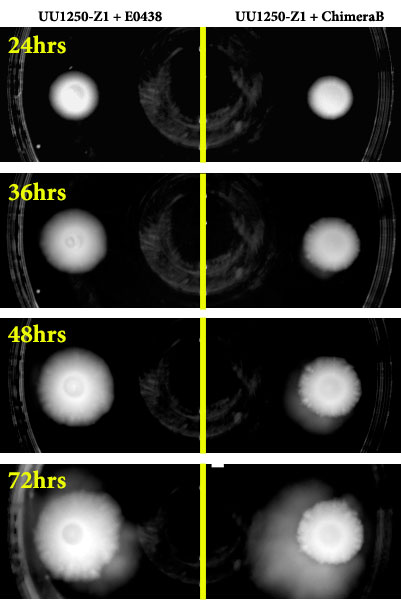
Gradient swarming plates were used to test for any active quorumtaxis present in UU1250-Z1 cells expressing the chimeric LuxN-Tsr receptors. Although the Chimera B is the most promising (see Figure 6), the efficiency of any observed quorumtaxis is quite inefficient, as is evident by the lack of bacteria flares until at least 48 hours. The inefficiency may be a result of:
- Non-optimal spacing of the LuxN sensor domain and the Tsr signaling domain.
- Non-optimal transcription/translation of the chimeric gene.
- Errors in the sequence as suggested by sequencing results.
Re-evaluation of the pSB1AC3 backbone used for the expression of the chimeras (and esp. the usage of the transcriptional terminators) indicates that other iGEM groups have encountered problems in transcriptional leakage of the transcriptional terminators, possibly resulting in over-expression of the construct.
'* Sequencing efforts have indicated sequence discrepancies in the chimeras which could account for the less than optimal quorumtaxis results.
Milestones Achieved
- Parental LuxN-Tsr chimeras achieved.
- Gradient swarming plate assays indicate Chimera B (LuxN1-345::Tsr216-551) seems to have greater movement towards regions corresponding to higher AI-1 concentrations, albeit at a much weaker efficiency than full-length Tsr.
Future Work
- Subclone full-length Tsr and all four chimeric constructs to plasmid pSB1A7, which contains MCS-flanking double terminators, to ensure transcriptional efficiency.
- Retest on gradient swarming plates.
- Construct ITCHY libraries using all chimeras as parental templates.
- Screen ITCHY chimeric receptor library for functional quorumtaxis.
- Further optimize any functional chimeras using directed evolution.


